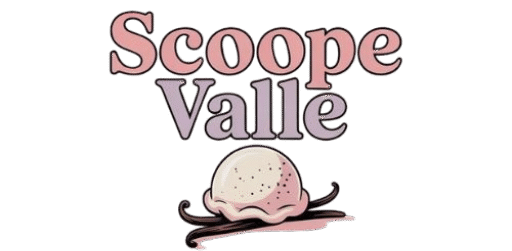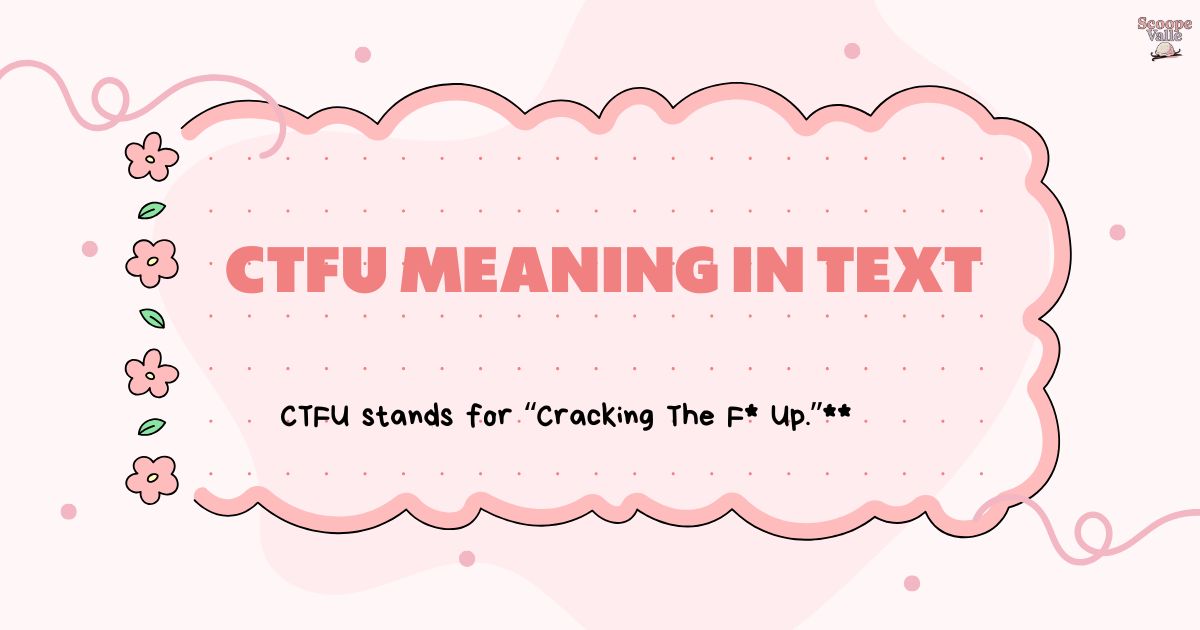The world of texting is full of short forms and funny slang. From LOL to ROFL, people love quick ways to show emotions. One acronym that often surprises new texters is CTFU. If you have ever seen a friend comment “CTFU 😂” under a meme or in a group chat, you might wonder what it really means.
This guide explains what CTFU stands for, where it came from, and how you can use it correctly. You will also learn about similar terms, cultural differences, and when to avoid.
Definition & Meaning
CTFU stands for “Cracking The F* Up.”** It is a slang term used when something is extremely funny much stronger than a simple LOL (Laughing Out Loud). When someone types CTFU, it means they are laughing so hard that they cannot stop.
Key points to remember:
- Strong laughter: CTFU shows a higher level of amusement than LOL or Haha.
- Informal tone: Because it contains a swear word (the “F”), it is meant for relaxed conversations with friends.
- Digital slang: You will mostly see it in texting, social media comments, gaming chats, or memes.
Example:
- Friend 1: “I just slipped while dancing on live video.”
- Friend 2: “CTFU, I need to see the replay! 😂”
Also read: IDT Meaning in Text: A Complete Guide (Latest)
Background & History
The birth of CTFU is closely tied to internet culture. Around the early 2000s, online forums, instant messaging apps, and chat rooms became popular. Users began creating bold abbreviations to express emotions quickly.
- Early Days: Acronyms like LOL, LMAO, and ROFL paved the way. People wanted stronger ways to show laughter, so “Cracking Up” evolved into CTFU with an added “F” for emphasis.
- Growth in the 2010s: Platforms like Twitter, Instagram, and Facebook gave it a wider audience. Memes, viral videos, and group chats helped CTFU become a common reaction to hilarious content.
- Present Use: Today, CTFU is still trending among Gen Z and millennials, especially in meme-heavy communities and gaming servers.
The edgy “F” makes it stand out from older terms and keeps it exciting for people who enjoy playful, exaggerated humor.
Usage in Various Contexts
CTFU is flexible and can fit many fun situations. Here are the most common settings:
1. Texting
Friends use CTFU to react to a funny message or photo.
Example:
Friend: “I just sent my teacher a selfie instead of homework.”
You: “CTFU, that’s priceless!”
2. Social Media
It often appears in comments under hilarious posts or memes.
Example: “This cat video has me CTFU 😂 #TooFunny”
3. Gaming
Gamers use it when something ridiculous or unexpected happens.
Example: “That glitch had the whole team CTFU.”
4. Group Chats
It works perfectly in family or friend groups for everyday funny moments.
Example: “Grandpa just used Snapchat filters…CTFU!”
Common Misconceptions & Clarifications
Because of its bold look, CTFU can be misunderstood. Let’s clear up some common myths:
- Misconception 1: It is polite.
Truth: The “F” makes it edgy and informal. Avoid it in professional or sensitive conversations. - Misconception 2: It has many meanings.
Truth: CTFU almost always means Cracking The F** Up*. Rarely will it mean anything else. - Misconception 3: It is safe for all ages.
Truth: Teens and adults may use it freely, but the swear word might not be suitable for kids.
Similar Terms & Alternatives
Not everyone wants to use strong language. Here are popular alternatives:
| Term | Full Form | When to Use |
|---|---|---|
| LOL | Laughing Out Loud | Safe for all audiences, polite conversations |
| LMAO | Laughing My A** Off | Casual and slightly bold |
| ROFL | Rolling On the Floor Laughing | Playful, over-the-top humor |
| Haha | Simple laughter | Everyday texting, universal |
How to Respond to This Term
When a friend sends CTFU, your reply can match their energy. Here are some ideas:
- Casual Response:
“Same! I can’t stop laughing either 😂” - Playful Tease:
“CTFU too, you always find the funniest stuff.” - Neutral Reply:
“That’s really funny. Where did you find it?”
Your goal is to keep the conversation light. If the chat is more serious, you can simply respond with a smile emoji or “That’s funny.”
Regional or Cultural Differences
While CTFU is popular in English-speaking countries, usage differs worldwide.
- Western Countries (US, UK, Canada): Common among younger users on social media and texting.
- Non-English Regions: Recognized in global gaming or meme groups, but not as widespread.
- Conservative Cultures: The explicit “F” makes it less acceptable. People may prefer neutral laughter terms like “LOL.”
Always consider the background of the person you are chatting with. A simple LOL might save you from an uncomfortable reaction.
Comparison with Similar Terms
How does CTFU stack up against other laughter acronyms?
| Acronym | Intensity | Tone | Example |
|---|---|---|---|
| CTFU | Very strong | Edgy, bold | “That meme had me CTFU for minutes!” |
| LOL | Mild | Friendly, safe | “LOL, that was cute.” |
| LMAO | Strong | Slightly bold | “I’m LMAO at this fail video.” |
| ROFL | Strong & playful | Funny exaggeration | “ROFL! I can’t even breathe.” |
Key Takeaway: Use CTFU when you want to express extreme laughter with friends who are okay with strong language.
Usage in Online Communities & Dating Apps
CTFU has found a home in many digital spaces:
- Twitter/X: People reply “CTFU” to trending memes and viral clips.
- Instagram & TikTok: Common in comments on funny reels or videos.
- Discord & Gaming Chats: Perfect for sharing laughs after a crazy in-game moment.
- Dating Apps: Some users put it in their bio to show they love humor.
- Example Bio: “Send me memes that will have us both CTFU.”
If you use CTFU on dating apps, pair it with a friendly question like “What meme last had you CTFU?” to keep the conversation playful.
Hidden or Offensive Meanings
CTFU is straightforward, but it comes with a language warning:
- The “F” stands for a curse word, which many people find offensive.
- It can appear too aggressive in polite company.
- Some workplaces or schools might block messages containing it.
If you are unsure how someone might react, choose a cleaner alternative like LOL or ROFL.
Suitability for Professional Communication
CTFU is not suitable for work emails, business chats, or formal settings. Here’s why:
- Explicit language: Even if hidden by the acronym, the swear word is still implied.
- Unprofessional image: It may make you seem careless or disrespectful.
- Risk of misinterpretation: Colleagues from different cultures might not understand it.
Better options for professional spaces:
- “That’s funny!”
- “Haha, good one.”
- “LOL” (if the workplace is casual)
FAQ’s
Q1: What does CTFU mean in texting?
It means Cracking The F** Up*, used to show that something is extremely funny.
Q2: Is CTFU safe to use with strangers?
Not always. Because it contains a swear word, it’s better for friends or close contacts.
Q3: Can I use CTFU at work?
No. It is too informal and can be seen as offensive in professional settings.
Q4: Are there cleaner alternatives to CTFU?
Yes, you can use LOL, LMAO, ROFL, or simply “Haha.”
Q5: Where is CTFU most common?
It’s most popular in English-speaking social media spaces like Twitter, Instagram, and Discord.
Q6: Does everyone know what CTFU means?
Not always. Older adults or people outside English internet culture might not recognize it.
Q7: How can I reply to someone who sends CTFU?
You can respond with “Same here 😂,” “That’s hilarious,” or share another funny comment.
Conclusion
CTFU is one of the funniest and boldest acronyms in the digital world. Standing for Cracking The F* Up**, it shows that something is so hilarious that ordinary laughter words just aren’t enough.
Use it when chatting with friends, reacting to memes, or enjoying gaming moments. But remember its informal and edgy nature it is not meant for professional emails, school assignments, or conservative settings.
Whether you stick with CTFU or choose softer options like LOL or ROFL, knowing its meaning keeps you part of the conversation. Next time you see someone comment “CTFU 😂”, you’ll know exactly why they are laughing—and you might just join in the fun.
Tylor John, with five years’ experience, beautifully crafts information on all topics and inspiring readers worldwide with positivity, faith, creativity, love, and hope.

